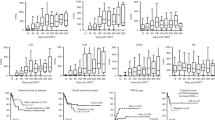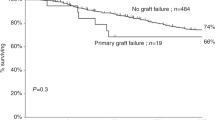Abstract
Management of monoclonal lymphoproliferative disease following stem cell transplantation is difficult and previous attempts to eradicate tumor using chemotherapy or radiation therapy alone have not been successful. We report successful early eradication of an EBV negative, B cell non-Hodgkin's lymphoma in a child who received a T cell-depleted, maternal haploidentical bone marrow transplant for severe combined immunodeficiency disease. Our treatment strategy involved combining conventional induction chemotherapy with re-transplantation using the paternal donor as a source of peripheral blood stem cells, followed by treatment with anti-CD 20 monoclonal antibody (Rituximab). This strategy exploits the potential graft-versus-tumor activity of the mature T cells in the graft, while providing a source of stem cells to confer long-term immune function. The administration of Rituximab in the early post-transplant course may provide additional anti-tumor activity without affecting the new stem cell compartment. Bone Marrow Transplantation (2001) 27, 329–332.
This is a preview of subscription content, access via your institution
Access options
Subscribe to this journal
Receive 12 print issues and online access
$259.00 per year
only $21.58 per issue
Buy this article
- Purchase on Springer Link
- Instant access to full article PDF
Prices may be subject to local taxes which are calculated during checkout


Similar content being viewed by others
References
Swerdlow SH . Post-transplant lymphoproliferative disorders: a morphologic, phenotypic and genotypic spectrum of disease Histopathology 1992 20: 373–385
Fischer A, Blanche S, Bidois J et al. Anti-B cell monoclonal antibodies in the treatment of severe B-cell lymphoproliferative syndrome following bone marrow and organ transplantation New Engl J Med 1991 324: 1451–1456
Heslop HE, Brenner MK, Rooney CM . Donor T cells as therapy for EBV lymphoproliferation post bone marrow transplant New Engl J Med 1994 331: 679–680
Papadopoulos EB, Ladanyi M, Emanuel D et al. Infusions of donor leukocytes to treat Epstein–Barr virus-associated lymphoproliferative disorders after allogeneic bone marrow transplantation New Engl J Med 1994 330: 1185–1191
Rooney CM, Smith CA, Ng CYC et al. Use of gene modified virus-specific T lymphocytes to control Epstein–Barr virus-related lymphoproliferation Lancet 1995 345: 9–13
Rooney CM, Smith CA, Ng CYC et al. Infusion of cytotoxic T cells for the prevention and treatment of Epstein–Barr virus-induced lymphoma in allogeneic transplant recipients Blood 1998 92: 1549–1555
Wagner HJ, Bein G, Bitsch A et al. Detection and quantification of latently infected B lymphocytes in Epstein–Barr virus-seropositive, healthy individuals by polymerase chain reaction J Clin Microbiol 1992 30: 2826–2829
Trainor KJ, Brisco MJ, Wan JH et al. Gene rearrangement in B- and T-lymphoproliferative diseases detected by the polymerase chain reaction Blood 1991 78: 192–196
Maise RL, Segal GH, Iturraspe JA et al. The cell surface antigen and DNA content distribution of lymph nodes with reactive hyperplasia Mod Pathol 1995 8: 536–543
Gross TG, Hinrichs SH, Davis JR et al. Depletion of EBV-infected cells in donor marrow by counterflow elutriation Exp Hematol 1998 26: 395–399
Buckley RH . Transplantation. In: Steihm ER (ed.) Immunologic Disorders in Infants and Children W.B. Saunders: Philadelphia 1996 pp 1014–1058
Benkerrou M, Durandy A, Fischer A . Therapy for transplant-related lymphoproliferative diseases Hematol Oncol Clin North Am 1993 7: 467–475
McGuirk JP, Seropian S, Howe G et al. Use of rituximab and irradiated donor-derived lymphocytes to control Epstein–Barr virus-associated lymphoproliferation in patients undergoing related haplo-identical stem cell transplantation Bone Marrow Transplant 1999 24: 1253–1258
Kuehnle I, Huls MH, Liu Z et al. CD20 monoclonal antibody (rituximab) for therapy of Epstein–Barr virus lymphoma after hemopoetic stem-cell transplantation Blood 2000 95: 1502–1505
Rituximab for non-Hodgkins Lymphoma The Medical Letter 1998 40: 65–66
Lamb LS, Gee AP, Henslee-Downey PJ et al. Phenotypic and functional reconstitution of peripheral blood lymphocytes following T cell-depleted bone marrow transplantation from partially mismatched related donors Bone Marrow Transplant 1998 21: 461–471
Author information
Authors and Affiliations
Rights and permissions
About this article
Cite this article
Skoda-Smith, S., Douglas, V., Mehta, P. et al. Treatment of post-transplant lymphoproliferative disease with induction chemotherapy followed by haploidentical peripheral blood stem cell transplantation and Rituximab. Bone Marrow Transplant 27, 329–332 (2001). https://doi.org/10.1038/sj.bmt.1702792
Received:
Accepted:
Published:
Issue Date:
DOI: https://doi.org/10.1038/sj.bmt.1702792



